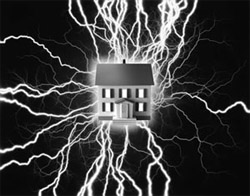Multiple sources of transient electrical noise (surges) including motors, HVAC equipment, photocopiers, power tools, etc, are present in all modern buildings.
Surge energy conveyed by building power systems may also result from external sources such as nearby lightning strikes.
To minimize the likelihood of injuries to personnel and damage to equipment due to electrical surges and accidental fault conditions, in North America the National Electrical Code (NEC) specifies that all exposed electrical equipment in building electrical systems is to be connected (“bonded”) together and ultimately bonded (“grounded”) to an earth “Building Ground” connection at the electrical Service Entrance.
This requirement is addressed by the building Equipment Grounding system.
Equipment Grounding (EG) systems incorporate combinations of conduits, raceways, and dedicated Equipment Ground conductors associated with the Hot and Neutral conductors of branch circuits.
Connections to EG systems are made via the “U-Ground” contacts (often referred to as the “Green Wire”) in electrical outlets.
By merely being “plugged-in”, installations of electronic equipment (computers, sound systems, etc.) are automatically “grounded” and thus made as safe as possible for operation by nontechnical personnel.
Interconnections and “Ground Loops”
Interconnections between groups of grounded electronic equipment via “network” cables (which incorporate dedicated signal and shield “ground” conductors) are commonplace.
Inductive coupling of powerline surge energy into the “Ground Loops” formed by these multiple “ground” connections is inevitable, as current will flow in any conductive path (loop) exposed to the magnetic fields associated with nearby power conductors and electrical equipment.
The consequences often appear as noise in sound systems, and mysterious computer network problems ranging from data corruption all the way to catastrophic failure of interface devices, and will be especially evident in installations involving equipment with Pin-1 Problems1.
It is often suggested that “surge suppressors” (devices which limit the magnitude of surge energy) might address these problems. Power “Outlet Bars” with internal “Shunt Mode” circuitry are obtained and installed in various equipment locations throughout the building.
While perhaps surprising, it is not unusual to find that the net results from these efforts often range from no difference at all through•vague “improvements” to outright worsening of the original problem(s). In some cases the “improvements” first realized will unpredictably disappear after some time for no apparent reason.















